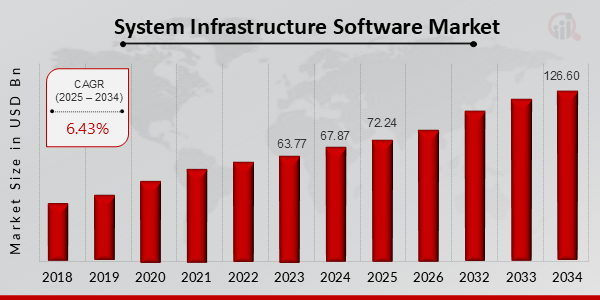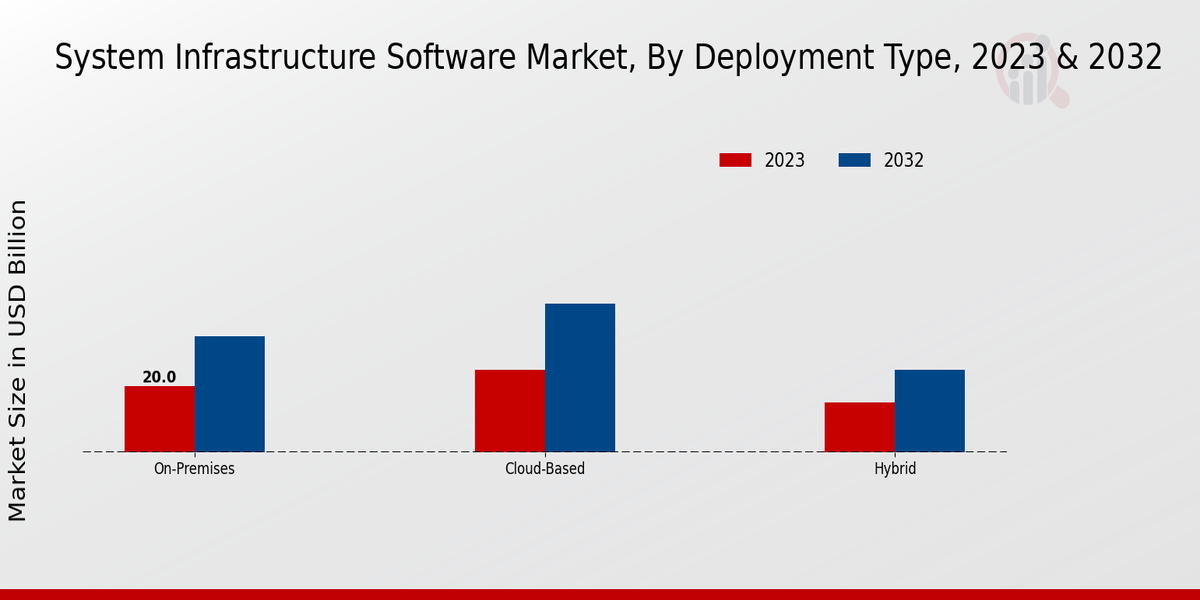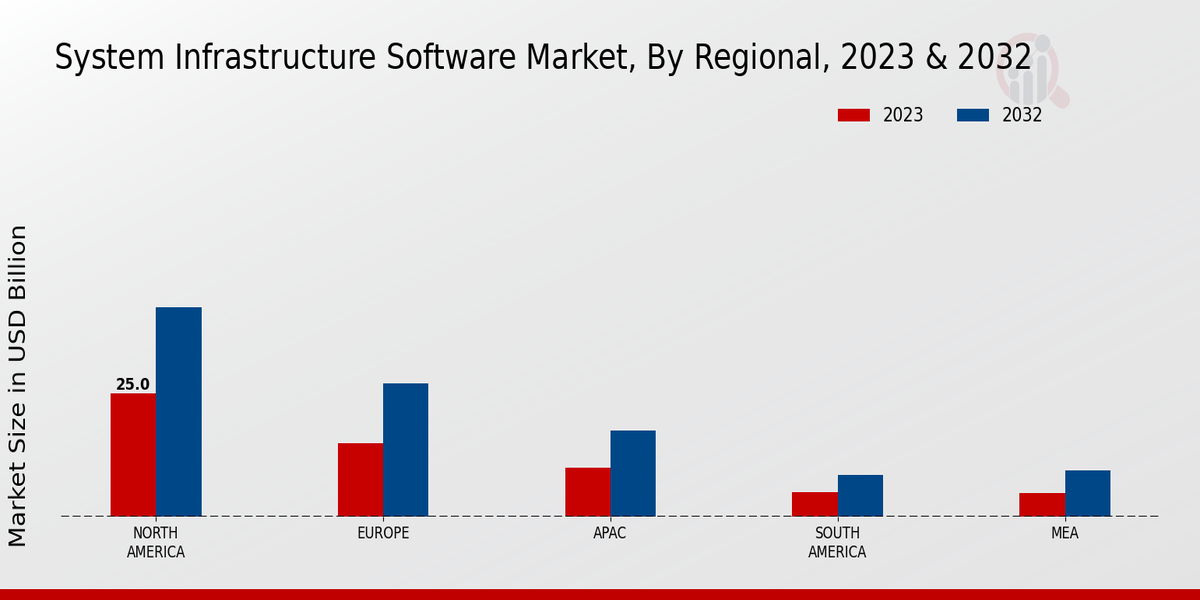System Infrastructure Software Market Overview
System Infrastructure Software Market is projected to grow from USD 72.24 Billion in 2025 to USD 126.60 Billion by 2034, exhibiting a compound annual growth rate (CAGR) of 6.43% during the forecast period (2025 - 2034). Additionally, the market size for System Infrastructure Software Market was valued at USD 67.87 billion in 2024.
Key System Infrastructure Software Market Trends Highlighted
The Global System Infrastructure Software Market is significantly driven by increasing demand for efficient management of IT resources. As businesses expand their digital footprint, the need for robust infrastructure solutions that can support scalability and flexibility has become paramount. Organizations are focusing on enhancing operational efficiency, which leads to a rise in the adoption of software solutions that streamline processes. Concerns about data security and compliance also push enterprises to seek advanced infrastructure software that can ensure the safe management of sensitive information. As opportunities evolve within this market, there is a noticeable shift towards cloud-based solutions.
Companies are increasingly exploring the benefits of virtualization and cloud technologies, which not only reduce costs but also improve accessibility and collaboration. The rise of artificial intelligence and machine learning in system infrastructure software opens up avenues for more intelligent data management and automation. Organizations can capture these opportunities by investing in tools that enable better resource allocation and predictive analysis, enhancing decision-making capabilities. Recent trends indicate a growing interest in sustainable and energy-efficient software solutions. Businesses are becoming more conscious of their environmental impact and are seeking infrastructure software that supports green IT initiatives.
Moreover, integration capabilities are increasingly regarded as essential, allowing businesses to combine various software tools seamlessly. This integration fosters a more agile environment, enabling organizations to adapt swiftly to market changes or technological advancements. As the landscape continues to evolve, companies that align their strategies with these trends will be better positioned for future success in the Global System Infrastructure Software Market.
Figure1: System Infrastructure Software Market, 2025 - 2034

Source: Primary Research, Secondary Research, Market Research Future Database and Analyst Review
System Infrastructure Software Market Drivers
Increased Demand for Automation and Virtualization
The Global System Infrastructure Software Market Industry is witnessing a substantial rise in demand for automation and virtualization solutions, which is significantly driving market growth. Organizations across various sectors are increasingly relying on automation technologies to streamline operations, enhance productivity, and reduce costs. With the growing complexity of IT infrastructures, businesses are looking for software solutions that can automate routine tasks and manage processes more efficiently.
The push for virtualization also stems from the need to optimize resource utilization, improve scalability, and reduce physical hardware requirements. By adopting virtualization technologies, companies can create multiple simulated environments on a single physical hardware system, which allows for better flexibility and management of resources. As businesses continue to embrace digital transformation initiatives, the need for advanced system infrastructure software that supports automation and virtualization functionalities will grow.
This trend is also driven by the rise of remote work and the need for robust IT environments that can support a dispersed workforce. Therefore, the increased demand for automation and virtualization significantly influences the trajectory of the Global System Infrastructure Software Market Industry, stimulating innovations and the development of new solutions to meet evolving business needs.
Rising Adoption of Cloud Computing Solutions
The shift towards cloud computing is a primary driver of growth in the Global System Infrastructure Software Market Industry. Organizations of all sizes are migrating to the cloud to leverage its flexibility, scalability, and cost-effectiveness. This transition requires specialized infrastructure software to manage cloud resources effectively, facilitating smoother operations and improved performance. The adoption of private, public, and hybrid cloud solutions necessitates a robust system infrastructure, making the demand for relevant software solutions crucial.
Expansion of IoT and Edge Computing
The proliferation of the Internet of Things (IoT) devices and the rise of edge computing is significantly influencing the Global System Infrastructure Software Market Industry. As more devices become interconnected, the need for software that can efficiently manage, process, and analyze data generated at the edge of networks grows. This trend is driving software providers to innovate and develop solutions that enhance connectivity, reduce latency, and improve data management, thereby contributing to the overall market growth.
System Infrastructure Software Market Segment Insights
System Infrastructure Software Market Deployment Type Insights
The Global System Infrastructure Software Market has shown significant growth in its Deployment Type segment, which is key to understanding the overall structure and appeal of the market. In 2023, the On-Premises segment was valued at 20.0 USD Billion, while the Cloud-Based deployment accounted for 25.0 USD Billion, and the Hybrid segment reached 14.92 USD Billion. This distribution highlights the growing preference for Cloud-Based solutions, which dominate the market due to their scalability, flexibility, and lower upfront investment costs compared to traditional On-Premises systems.
The Cloud-Based segment is essential because it facilitates access to sophisticated software applications remotely, enabling organizations to adopt more innovative approaches to IT infrastructure management without incurring high capital expenditures. The On-Premises segment, although trailing, still maintains a significant presence in the market, valued at 20.0 USD Billion in 2023, as many enterprises continue to prefer in-house data management for reasons related to compliance, security, and control. The Hybrid deployment type, valued at 14.92 USD Billion, represents a balance that many organizations find appealing, allowing them to leverage both on-premises and cloud solutions to optimize their operations and costs.
This deployment type often emerges as a strategic choice for companies aiming to mitigate risks associated with data breaches while maintaining some level of flexibility in resource management. The movement towards Cloud-Based solutions is influenced by a trend in digital transformation, where organizations are increasingly migrating to cloud environments to streamline operations and enhance collaboration. However, challenges such as data privacy concerns and integration complexities can impede the growth of this sector.
Overall, the Global System Infrastructure Software Market segmentation based on Deployment Type reflects varied preferences among organizations, driven by factors such as cost efficiency, security, and operational demands that foster a competitive environment among the On-Premises, Cloud-Based, and Hybrid deployment strategies.
As market growth continues, understanding these dynamics will be essential for stakeholders aiming to navigate the competitive landscape effectively.
Figure2: System Infrastructure Software Market, By Application, 2023 & 2032

Source: Primary Research, Secondary Research, Market Research Future Database and Analyst Review
System Infrastructure Software Market Software Type Insights
The Global System Infrastructure Software Market is projected to reach a value of 59.92 USD Billion in 2023, with substantial growth expected to follow, reflecting the increasing importance of software solutions to streamline operations. The Software Type segment comprises crucial applications such as Operating System Software, Database Management Software, Virtualization Software, and Middleware Software. Operating System Software plays a pivotal role as it provides a foundation for all other software to function effectively, ensuring optimal performance and resource management.
Database Management Software is significant due to the rising demand for efficient data handling, which supports informed decision-making in various sectors. Virtualization Software is gaining traction as it enables better resource allocation and cost reduction in IT environments. Meanwhile, Middleware Software acts as a bridge, facilitating communication and data management between disparate applications, which is increasingly vital as businesses adopt complex IT architectures.
Together, these components contribute significantly to the Global System Infrastructure Software Market revenue, driving market growth and reflecting the evolving demands of the industry, supported by market trends such as increased cloud adoption and the need for enhanced data security.
With a projected market value of 105.0 USD Billion by 2032, the industry is set to experience robust development, catering to various technological advancements while navigating associated challenges.
System Infrastructure Software Market End User Insights
In 2023, the Global System Infrastructure Software Market was valued at 59.92 USD Billion, reflecting a strong demand in various sectors. The End User segment of this market encompasses a diverse range of industries, including IT companies, government entities, banking, financial services, insurance (BFSI), healthcare, and manufacturing. Each of these sectors plays a vital role in driving market growth. IT companies are pivotal due to their ongoing need for robust infrastructure to support digital transformations.
The government sector relies heavily on this software for enhancing operational efficiency and service delivery to citizens.BFSI is significant as it demands high security and data management capabilities to safeguard financial transactions. Healthcare organizations utilize these solutions to streamline patient data management and regulatory compliance. Manufacturing leverages system infrastructure software to optimize production processes and supply chain management. This diversified usage underscores the importance of the End User segment, contributing to the overall Global System Infrastructure Software Market revenue and its trajectory towards a projected valuation of 105.0 USD Billion by 2032.
The market growth is supported by trends like increasing digitalization and the adoption of cloud computing technologies across these sectors.
System Infrastructure Software Market Functionality Insights
The Global System Infrastructure Software Market, valued at 59.92 USD Billion in 2023, showcases a robust growth trajectory driven predominantly by its diverse functionality segment. This segment encompasses critical areas such as System Management, Network Management, Security Management, and Data Storage Management, each playing a vital role in enhancing operational efficiency and security. System Management streamlines IT operations, while Network Management is crucial for maintaining and optimizing network performance. Security Management remains significant given the rising cybersecurity threats, ensuring data integrity and compliance with regulations.
Additionally, Data Storage Management supports the growing demand for data functionality, enabling efficient data handling and retrieval. The interplay of these functionalities not only drives market growth but also reflects the industry's response to evolving technological needs, with the overall Global System Infrastructure Software Market poised for significant expansion in the coming years.
System Infrastructure Software Market Regional Insights
The Regional segment of the Global System Infrastructure Software Market showcases significant diversity in market valuation and growth potential across various regions. In 2023, North America leads with a valuation of 25.0 USD Billion, reflecting a majority holding within the market due to its advanced technological landscape and high investment levels. Europe follows closely with 15.0 USD Billion, representing a significant player in the market due to strong regulatory environments and an increasing emphasis on digital transformation.
The APAC region, valued at 10.0 USD Billion in 2023, is witnessing rapid growth driven by an expanding customer base and increasing digital adoption, demonstrating ample opportunities for growth.
South America and MEA are valued at 5.0 USD Billion and 4.92 USD Billion, respectively, showing a growing interest in system infrastructure software solutions but still possessing a smaller market share. These regional insights underline the varying dynamics across the Global System Infrastructure Software Market, emphasizing North America's dominance while highlighting the growth potential in APAC and other emerging markets, which play a crucial role in shaping the future of the industry. As the Global System Infrastructure Software Market revenue evolves, the segmentation reveals critical trends and opportunities for stakeholders.
Figure3: System Infrastructure Software Market, By Regional, 2023 & 2032

Source: Primary Research, Secondary Research, Market Research Future Database and Analyst Review
System Infrastructure Software Market Key Players and Competitive Insights
The Global System Infrastructure Software Market is a vital segment of the IT industry that supports the foundational software structures within various organizations, facilitating the operations of applications, services, and hardware systems. This market has gained momentum due to the ongoing digital transformation in enterprises seeking streamlined operations, increased productivity, and improved resource management. Competitive insights into this market reveal the presence of numerous key players offering a range of products and services. These players leverage emerging technologies such as artificial intelligence, cloud computing, and automation to achieve a competitive edge.
The market is characterized by rapid innovation, strategic partnerships, and acquisitions, allowing companies to enhance their offerings and adapt to evolving customer needs.
Microsoft has established itself as a significant leader within the Global System Infrastructure Software Market. The company's strengths lie in its diverse product portfolio, which includes operating systems, server management, and virtualization solutions that cater to a variety of customer requirements. Microsoft’s Azure platform is a critical component of its infrastructure software strategy, providing cloud-based services that enable organizations to manage their IT resources more efficiently. Furthermore, Microsoft’s extensive ecosystem, combined with its robust customer support network, reinforces its market presence.
The company invests heavily in research and development to stay ahead of technological advancements, constantly releasing updates and new features that meet the dynamic demands of the market.
Hewlett Packard Enterprise has also carved a niche for itself in the Global System Infrastructure Software Market. The company is known for its strong focus on hybrid IT solutions, allowing businesses to leverage both on-premises and cloud environments seamlessly. Hewlett Packard Enterprise's strengths include its comprehensive portfolio of infrastructure software products designed to optimize performance and enhance security for enterprise systems. The firm places a strong emphasis on innovation, utilizing machine learning and predictive analytics to aid in system management and optimization.
Additionally, Hewlett Packard Enterprise fosters strategic alliances and collaborations with other tech leaders, further solidifying its position in the market. Its commitment to delivering sustainable and efficient solutions resonates well with organizations looking to modernize their IT infrastructures.
Key Companies in the System Infrastructure Software Market Include
System Infrastructure Software Market Industry Developments
Recent developments in the Global System Infrastructure Software Market indicate a dynamic sector driven by cloud computing and digital transformation. Companies like Microsoft and Amazon have been expanding their cloud service offerings, enabling organizations to leverage advanced infrastructure solutions that enhance operational efficiencies. IBM has also announced significant enhancements to its hybrid cloud platform, focusing on integrating AI capabilities to improve decision-making processes. In terms of acquisitions, HPE acquired a software firm this year to bolster its edge computing capabilities, while Oracle announced the acquisition of a cloud startup to enhance its data management services.
Meanwhile, VMware is prioritizing software-defined infrastructure advancements to cater to the growing demand for flexible IT environments. Red Hat continues to strengthen its position in the open-source domain, collaborating with enterprises seeking to optimize their workflows.
The recent trends highlight the importance of sustainability and security in infrastructure solutions, reflecting an industry-wide shift towards more resilient technology frameworks. As competition intensifies, these developments are setting the stage for sustained growth in the market, influencing investment and innovation strategies among leading players like Cisco, Salesforce, and SAP.
System Infrastructure Software Market Segmentation Insights
-
System Infrastructure Software Market Deployment Type Outlook
-
System Infrastructure Software Market End User Outlook
-
System Infrastructure Software Market Functionality Outlook
-
System Infrastructure Software Market Regional Outlook
|
Report Attribute/Metric
|
Details
|
|
Market Size 2024
|
67.87 (USD Billion)
|
|
Market Size 2025
|
72.24 (USD Billion)
|
|
Market Size 2034
|
126.60 (USD Billion)
|
|
Compound Annual Growth Rate (CAGR)
|
6.43% (2025 - 2034)
|
|
Report Coverage
|
Revenue Forecast, Competitive Landscape, Growth Factors, and Trends
|
|
Base Year
|
2024
|
|
Market Forecast Period
|
2025 - 2034
|
|
Historical Data
|
2019 - 2023
|
|
Market Forecast Units
|
USD Billion
|
| Key Companies Profiled |
Microsoft, Hewlett Packard Enterprise, Oracle, IBM, Pivotal Software, Red Hat, Salesforce, Google, Atlassian, Cisco, VMware, ServiceNow, SAP, Micro Focus, Amazon |
| Segments Covered |
Deployment Type, Software Type, End User, Functionality, Regional |
| Key Market Opportunities |
Cloud computing integration, Enhanced security solutions, AI-driven automation tools, Cross-platform compatibility advancements, Increased demand for virtualization |
| Key Market Dynamics |
Cloud adoption is increasing, Rapid digital transformation, Rising cybersecurity concerns, Demand for operational efficiency, and Integration of AI technologies. |
| Countries Covered |
North America, Europe, APAC, South America, MEA |
Frequently Asked Questions (FAQ):
The Global System Infrastructure Software Market is projected to be valued at 126.60 USD Billion in 2034.
The expected CAGR for the Global System Infrastructure Software Market from 2025 to 2034 is 6.43%.
By 2032, North America is expected to hold the largest market value at 42.5 USD Billion.
The market value of Cloud-Based System Infrastructure Software is projected to reach 45.0 USD Billion in 2032.
Key players in the market include Microsoft, Hewlett Packard Enterprise, Oracle, and IBM, among others.
In 2023, the On-Premises segment of the Global System Infrastructure Software Market is valued at 20.0 USD Billion.
The APAC region is expected to grow to a market value of 17.5 USD Billion by 2032.
The projected market value of the Hybrid segment is anticipated to be 25.0 USD Billion in 2032.
Challenges such as rapid technological changes and market saturation could impact growth in the Global System Infrastructure Software Market.
The South America region is valued at 5.0 USD Billion in the Global System Infrastructure Software Market in 2023.

















